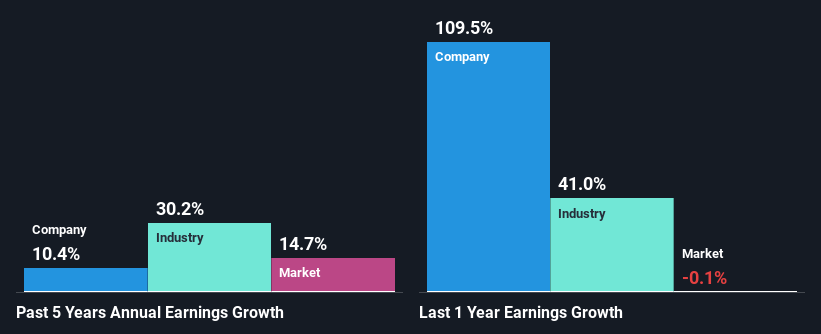Most readers would already be aware that VEEM’s (ASX:VEE) stock increased significantly by 57% over the past three months. Given the company’s impressive performance, we decided to study its financial indicators more closely as a company’s financial health over the long-term usually dictates market outcomes. In this article, we decided to focus on VEEM’s ROE.
Return on equity or ROE is a key measure used to assess how efficiently a company’s management is utilizing the company’s capital. In other words, it is a profitability ratio which measures the rate of return on the capital provided by the company’s shareholders.
View our latest analysis for VEEM
How Do You Calculate Return On Equity?
The formula for ROE is:
Return on Equity = Net Profit (from continuing operations) ÷ Shareholders’ Equity
So, based on the above formula, the ROE for VEEM is:
12% = AU$5.8m ÷ AU$50m (Based on the trailing twelve months to December 2023).
The ‘return’ is the yearly profit. So, this means that for every A$1 of its shareholder’s investments, the company generates a profit of A$0.12.
Why Is ROE Important For Earnings Growth?
We have already established that ROE serves as an efficient profit-generating gauge for a company’s future earnings. We now need to evaluate how much profit the company reinvests or “retains” for future growth which then gives us an idea about the growth potential of the company. Assuming everything else remains unchanged, the higher the ROE and profit retention, the higher the growth rate of a company compared to companies that don’t necessarily bear these characteristics.
VEEM’s Earnings Growth And 12% ROE
To start with, VEEM’s ROE looks acceptable. Further, the company’s ROE is similar to the industry average of 13%. Consequently, this likely laid the ground for the decent growth of 10% seen over the past five years by VEEM.
As a next step, we compared VEEM’s net income growth with the industry and were disappointed to see that the company’s growth is lower than the industry average growth of 30% in the same period.
The basis for attaching value to a company is, to a great extent, tied to its earnings growth. It’s important for an investor to know whether the market has priced in the company’s expected earnings growth (or decline). By doing so, they will have an idea if the stock is headed into clear blue waters or if swampy waters await. If you’re wondering about VEEM’s’s valuation, check out this gauge of its price-to-earnings ratio, as compared to its industry.
Is VEEM Efficiently Re-investing Its Profits?
With a three-year median payout ratio of 30% (implying that the company retains 70% of its profits), it seems that VEEM is reinvesting efficiently in a way that it sees respectable amount growth in its earnings and pays a dividend that’s well covered.
Moreover, VEEM is determined to keep sharing its profits with shareholders which we infer from its long history of seven years of paying a dividend. Our latest analyst data shows that the future payout ratio of the company over the next three years is expected to be approximately 30%. Therefore, the company’s future ROE is also not expected to change by much with analysts predicting an ROE of 13%.
Conclusion
On the whole, we feel that VEEM’s performance has been quite good. In particular, it’s great to see that the company is investing heavily into its business and along with a high rate of return, that has resulted in a respectable growth in its earnings. With that said, the latest industry analyst forecasts reveal that the company’s earnings are expected to accelerate. Are these analysts expectations based on the broad expectations for the industry, or on the company’s fundamentals? Click here to be taken to our analyst’s forecasts page for the company.
Have feedback on this article? Concerned about the content? Get in touch with us directly. Alternatively, email editorial-team (at) simplywallst.com.
This article by Simply Wall St is general in nature. We provide commentary based on historical data and analyst forecasts only using an unbiased methodology and our articles are not intended to be financial advice. It does not constitute a recommendation to buy or sell any stock, and does not take account of your objectives, or your financial situation. We aim to bring you long-term focused analysis driven by fundamental data. Note that our analysis may not factor in the latest price-sensitive company announcements or qualitative material. Simply Wall St has no position in any stocks mentioned.
Credit: Source link




